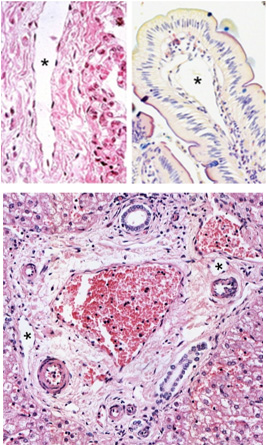 Lymphatic vessels drain
interstitial fluid (lymph) from tissues and organs, carry it to
lymph nodes where it’s filtered, and eventually join the thoracic
duct and right lymphatic duct that empty into the venous system.
Unlike the blood vasculature that has the heart to pump blood
through the vessels, lymph is moved through lymphatic vessels
primarily by the movement of surrounding organs and tissues. Lymphatic vessels drain
interstitial fluid (lymph) from tissues and organs, carry it to
lymph nodes where it’s filtered, and eventually join the thoracic
duct and right lymphatic duct that empty into the venous system.
Unlike the blood vasculature that has the heart to pump blood
through the vessels, lymph is moved through lymphatic vessels
primarily by the movement of surrounding organs and tissues.
- Examine lymphatic vessels in the
images to the right (asterisks mark the lumens) and in these
three slides (sample
1, sample 2,
sample 3).
Sometimes lymph will be present in the lumens, which along with
the very thin endothelium, is a distinctive, identifying feature
of lymphatic vessels.
- In this
specimen of liver, examine the
portal areas (seen in the image at the right). Portal areas
contain arterioles, veins, bile ducts, and lymphatic vessels,
providing an excellent opportunity to compare these structures.
Asterisks mark the lumens of the lymphatic vessels.
Now,
try this short quiz to practice
what you’ve learned.
Now for the
respiratory system. |